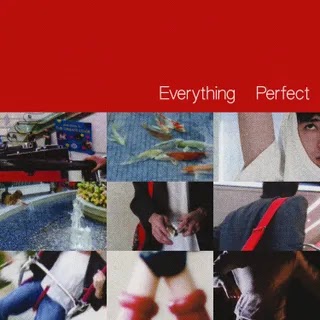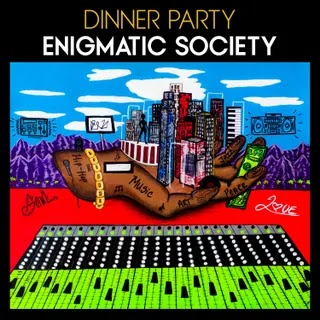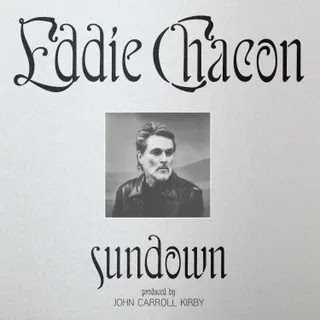A speculative-fiction multimedia project imagines the future sounds of South Texas’ Rio Grande Valley, using an apocalyptic future to pay tribute to the border region’s resilience.
What might our future look like viewed through the lens of the past? For scholar Jonathan Leal and producer/filmmaker Charlie Vela, both musicians and natives of the Rio Grande Valley region of South Texas, it looks like Futuro Conjunto. A sci-fi narrative “transmedia” project set 250 years hence that features audio, video, animation, and fictive found objects, Futuro Conjunto focuses its gaze on the RGV, a 100-mile floodplain along the Texas-Mexico border that follows the Rio Grande to its terminus at the Gulf of Mexico.
Packaged in a multimedia website and accompanied by a digital album available on Bandcamp, Futuro Conjunto tells the story of a young man seeking, finding, and listening to a damaged bootleg recording of a concert that took place in 2120 in an abandoned rocket facility in Boca Chica, Texas. The concert was produced by a mutual-aid network formed during the Second Mexican-American War, which began in the wake of a massive hurricane that reshaped the Rio Grande, and in turn, the U.S.-Mexico border. In the year 2200, a young man visits a repository of knowledge called El Centro Conmatizque looking for information about a concert that, according to family lore, his great-great-great-great-grandmother once played. It’s there, at the ECC, that the narrative begins.
Futuro Conjunto’s speculative sci-fi is rooted in plausibility, its story driven by events that feel like fiction only because they haven’t happened yet. The website offers an expository timeline that places the record within its context; the fictional group MUNDO’s song title “Futurasquache” is explained as the philosophy of the Colonia Cosmica, a sustainable self-governing settlement that recycles technology; breakthroughs in “tachyon modeling and quantum computing” lead to an AI revolution that includes AI musicians, one of whom, JUL/3Z, performs on “The Run Pt. II.”
It’s all incredibly nerdy, with the kind of attention to detail and historical nuance expected of a postdoctoral fellow studying “race and ethnicity through intersections of literary criticism, ethnomusicology, and performance studies.” At Stanford for his Ph.D, Leal first reached out to Vela after seeing As I Walk Through The Valley, the documentary Vela made with Ronnie Garza on the RGV’s musical history. Skeptical at first—having fielded plenty of suspect requests for access to Valley musicians after the release of his film—Vela eventually opened up once he realized that they could use academic grants to support his local scene. Their first project together, Wild Tongue, was a compilation of local acts that served as a snapshot of the area’s music scene—hip-hop, electro pop, country, indie rock, tejano, and rancheras—rooted in the artists’ experiences in the Valley.
Futuro Conjunto’s music was largely written and performed by Leal and Vela themselves, who then brought in many of those same musicians to perform as members of the fictional bands they created. Their influence on Vela and Leal is undeniable; you can hear echoes of Wild Tongue in Futuro Conjunto, projecting the POV of the Valley’s artists, scholars, and activists onto an imagined pseudo-apocalyptic future.
Though marked by tragedy, that future is far from dystopian; it’s marked by an underlying current of resilience, an enduring hope that there will always be a resistance. “Futurasquache” champions the Colonia Cosmica’s “Basura Bandits,” who hijack garbage trucks and dump their toxic contents on the doorstep of the elite gated community whence it came. Amid squealing guitars and electronic feedback, they find truth in the trash, building an entire worldview from recycling refuse. “When they tried to bury us/They didn’t know what we’d dig up/We know the truth because we’ve seen the past/It’s out there, buried underneath a hundred thousand plastic commemorative Selena cups!” Considering the Valley’s long-running intersection between activism and music, it’s fitting that the first song we hear would be a fiery missive from eco-bandits that battle the rich and powerful.
Despite the tone of that opening track, there’s a cheekiness throughout Futuro Conjunto that hints that its creators don’t take themselves too seriously. And it’s not immune to some mild cheese, either: CODEX’s “The Run Pt. II (ft. JUL/3Z)” is an overt nod to El-P and Killer Mike’s hip-hop buddy comedy, doing their best to ape El Producto’s SkyNet battle hymns, an admittedly impossible task. And the hurricane that decimates the Valley, re-shaping the landscape and setting the stage for a second Mexican-American war? Hurricane Narciso, as in Martinez, the father of conjunto music; La Mosca No Muere pay tribute to him with a song titled after his affectionate nickname, “El Huracán del Valle.”
The album’s strongest tracks are less overtly tied to the fictional universe, yet still speak to the Valley’s past and present. Simonada’s “Heatdeath” uses gorgeous multi-part harmonies and a chirping horn to channel Beach House’s melancholic malaise. And XXochitl’s ”La Madre de las Estrellas” features a prominent accordion melody from the son of Valley legend Esteban Jordan. The only song not written by Leal and Vela is a choral rendition of Fernando Z. Maldonado’s classic “Volver, Volver,” which serves as a coda to the fragmented livestream bootleg, arriving just before the police break up the concert.
Even removed from its narrative context, Futuro Conjunto still serves as a time capsule for the thriving independent arts and music scene in the Rio Grande Valley. The perspective is Leal and Vela’s, but few others are as well positioned to document this particular moment in time, and Vela’s Sound of Rain studio in Edinburgh, Tex., has served as a creative hub for many of the Valley’s musicians. More importantly, each of the fictional events that make up “The Flickering Century”—the 100-year period from 2020-2120 that the project covers—is rooted in a fundamental understanding of history, the Valley, the U.S., and humanity at large.
The timeline ends with measured hope: While the war ended with a cynically named “Treaty of Unbinding Illusion,” the citizens on each side of the re-shaped river form a new cross-border community called Rio Cristal, and a communal decree establishes El Centro Conmatizque, founded with the intention of retaining every piece of submitted data in perpetuity. It’s what allows the seeker to find the recording of the concert, spurred by a memory passed down to him through generation after generation. In the indigenous Nahuatl language, Conmatizque means “They will remember.” Futuro Conjunto represents the hope that our future salvation might be found in the remnants of our own history.
View the original article here
















0 comments:
Post a Comment